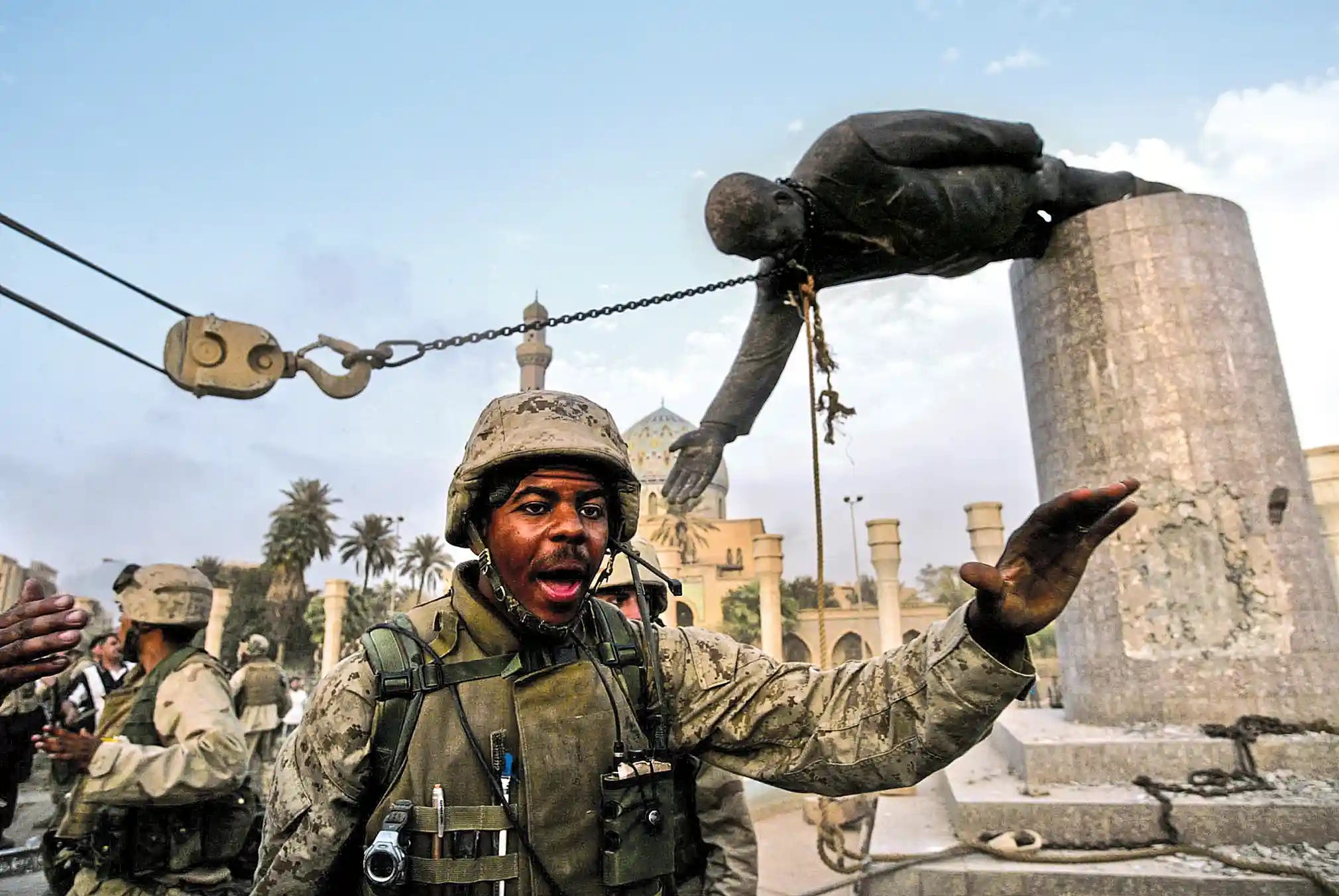The Toppling of Saddam's Statue: Act II
Baghdad fell twenty years ago today. But it was just the beginning of a long and bloody war.
This is the second installment in a three-part series.
On April 9, 2003, Marines stormed into the center of Baghdad and helped a group of Iraqi citizens pull down a statue of their deposed leader. It was a made-for-TV moment, broadcast live to millions, and replayed ad nauseam. Commentators were breathless. CNN’s Wolf Blitzer declared the unfolding scene as, “the image that sums up the day and, in many ways, the war itself.”
Two photographs emerged as definitive frames of the event.
Reuters photographer Goran Tomasevic shot this photo of a Marine reacting to the falling statue. Wide-eyed and mouth agape, the soldier’s profile is perfectly-silhouetted, clearly separating him from the rest of the frame. Damage from a sledgehammer can be seen at the base of the statue (more on that in Act III).
Tomasevic’s photo was everywhere the following day.
A nearly-identical moment was captured by Associated Press photographer Jerome Delay. However, the base of the statue is covered by the soldier, his profile partially obstructed. The background is slightly sharper, revealing a crowd of soldiers and Iraqis passively watching the events unfold.
Delay’s images were also widely published, leading the front pages of The New York Times, The Miami Herald, and the Rocky Mountain News (RIP).
Associated Press photographer Ramzi Haidar captured this moment just after the statue fell. Some great details here — the myriad of faces and expressions are fascinating, the unintentional tilt adds some tension. Tomasevic and Delay can be seen at far left, making the pictures seen above.
TIME published James Nachtwey’s photo of the statue coming down on the TOC with an illustration by Roberto Parada on the cover. Nachtwey has a great photo of the head of the statue that’ll feature in part three of this series.
A small photo of the toppling by Ilkka Uimonen landed on the cover of Newsweek. Jerome Delay’s image of an Iraqi man celebrating with a soldier ran dominant.
As I mentioned in part one of this series, Peter Maass’ 2011 story in The New Yorker is critically important in fully understanding the complicated events of that day. The photo The New Yorker published with Maass’ story was shot by Alexandra Boulat.
Taken from atop the M-88 Hercules, Boulat brilliantly captures the chaos and dimensionality of the unfolding scene. Every time I look at it, I discover something new and am still struck by what I don’t see — smartphones. It’s magnificent.
Boulat was on assignment for National Geographic. Here’s how the magazine used her photo in the September 2003 issue.
“No one knew how the Iraqis would react when the Americans arrived in Baghdad, and at first I felt tense and scared,” Boulat wrote. “Just yesterday some jittery American soldiers in a tank shot at the Palestine Hotel, where I’m staying, killing two journalists.”
Sadly, Boulat died in 2007 after suffering a brain aneurysm. Boulat’s photo editor at National Geographic, Kurt Mutchler, wrote this moving tribute to her in 2013.
Other photographers with versions of the toppling: Gilles Bassignac, Franco Pagetti, Yuri Kozyrev, Ron Haviv, Robert Nickelsburg, Gary Knight, Kael Alford, Q. Sakamaki, Patrick Robert, Mike Moore, Markus Matzel, Kuni Takahashi, Koji Harada (and surely more, lmk).
The Guardian’s Sean Smith photographed a Marine holding back the crowd as the statue is pulled down. Look closely, all the different hands make this frame. The Guardian just published this in an excellent retrospective of Smith’s work from Iraq.
This painterly photo by Patrick Baz depicts a strikingly different mood — disinterest. There’s a lot to dissect, so many tiny stories happening all at once.
It’s also one of the few pictures that capture the presence of other journalists and photographers. Almost all of the photos of the statue coming down are from the same side, which is understandable — had one photographer moved to the other side, they would have been in everyone else’s frame. It’s a delicate dance.
Baz, shooting for Agence France-Presse, had photographed another statue earlier in the day, far different than the one in Firdos Square. “One guy had attached a Saddam statue to the back of his car with a cable,” Baz wrote in 2018. “He would stop whenever he would see a group of people, who would then gleefully hit the statue with the soles of their shoes.”
“The image was all the more strong because there wasn’t an American soldier in sight. Just the locals expressing what they felt about their country’s long-term dictator,” Baz added. “I could hardly believe my luck — I was the only photographer around.”
I'm also drawn to this photo by James Hill, taken minutes before the toppling, of a Marine bumming a smoke from an Iraqi man. Look at all the hands in this photo — incredible. The photo is symbolic of the relationship between American soldiers and Iraqi civilians.
“The moment felt far removed from the glorious and victorious symbolism that the statue toppling was meant to be,” Hill told me. “And, of course, it was not by chance the statue happened to be in front of the live position of CNN.”
















